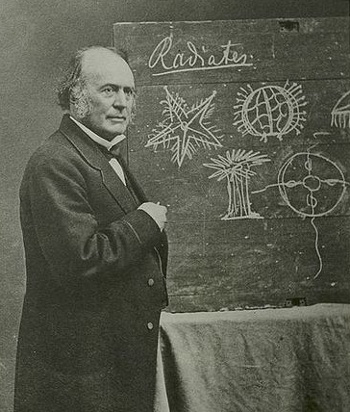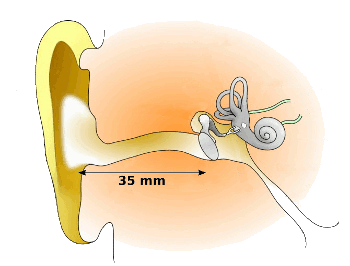Screech!
November 17, 2011
The
sound of fingernails scraping a blackboard is unpleasant. This sound affected me when I was younger, but years of listening to
Led Zeppelin must have desensitized me. The
National Science Foundation funded research on the topic in 1986,[1] and the research led to the award of an
Ig Nobel Prize.[2]
The Ig Nobel-winning NSF study was well-conceived. The researchers
digitally recorded a mimic of the sound, a sharp object scraping across a
slate surface, and they then modified its
frequency spectrum before playing it to a test panel of listeners. I hope that the test subjects were monetarily compensated for their ordeal.[2]
It was always thought that the high
frequencies in the sound were the discomfort trigger, but these experiments revealed that low frequencies are the culprit. The sound was found to be unpleasant at a wide range of
amplitudes. The
noisy, scraping portion of the spectrum was inconsequential.[2-3]

Swiss-American scientist Louis Agassiz of Harvard University at a chalkboard, which looks to be wooden, and not made of slate.
He is shown lecturing on the Radiata (Radiates).
Agassiz is known for his theories of the ice ages, but also for his resistance to Darwin's theory of evolution.
(Via Wikimedia Commons))
There's a saying that, when all you have is a hammer, everything looks like a nail.
Psychologists were certain that our reaction to this sound was the result of some primal memory. It was conjectured to be either an
alarm call, similar to that of
monkeys, or it was a sound made by a human
predator. That's why we're upset at hearing the sound, although we don't know exactly why.
This psychological theory, however, can't be proven correct, or
falsified, so no one can claim that it's a
scientific explanation. To the scientific mind, the question was still open, so
Christoph Reuter of the
Musicological Institute of the
University of Vienna, and
Michael Oehler of the
University of Cologne (Cologne, Germany), investigated the sound as a
physiological process. They presented their findings at the recent meeting of the
Acoustical Society of America in
San Diego, California.[3-6]
I've written about
resonance in quite a few articles, for example,
MEMS Resonator Logic Gate, April 4, 2011, simply because it's a very common physical phenomenon. Reuter and Oehler repeated the 1986 study with a few modifications. Not only were the listeners asked to rate the degree of unpleasantness of the sounds, but at the same time their
blood pressure,
heart rate and
galvanic skin conductivity were measured. It appears that the fingernail-blackboard effect is a resonance phenomenon. There's a resonance in the
human ear canal that amplifies frequencies in the range 2 - 4 kHz to a degree that they are above the threshold of pain.[3-6]

The human ear, showing the approximate length of the ear canal.
(Image by Dan Pickard, via Wikimedia Commons, modified))
A
closed tube, of which the ear canal is an example, will have a
resonance frequency because of its length. The resonance frequency
F of a closed tube is given as,
F = c / (4 L)
where
c is the
speed of sound, 343.2
meters per second (1,126
feet per second), and
L is the length of the tube. Since the ear canal is 35
mm in length (0.035 meters),
F = c / (4 L) = 343.2/(4 x 0.035) = 343.2/(0.14) = 2451 Hz
which is right in the frequency range identified as the culprit. One interesting result of the study is that listeners thought that the same sounds were less unpleasant when they were told that they were excerpts from
contemporary music compositions, although their physiological state was unchanged.[3-4]
This work has an obvious application to
electronic music composers, who intend to either mollify or discomfit their audience. It will also be helpful to equipment designers who try to make
vacuum cleaners and industrial equipment less noisy.[3]
References:
- Ig Nobel Award Winners for 2006, Journal of Improbable Research.
- D. Lynn Halpern, Randolph Blake and James Hillenbrand, "Psychoacoustics of a Chilling Sound," Perception and Psychophysics, vol. 39, no. 2 (March, 1986), pp. 77-80.
- Kim Krieger, "Cover Your Ears!" Science, October 28, 2011.
- Duncan Geere, "Ear canal design blamed for fingernail blackboard excrutiation," Wired (UK), November 1, 2011.
- Christoph Reuter and Michael Oehler, "Psychoacoustics of chalkboard squeaking," Abstract 4pPP6 of the 162nd Meeting of the Acoustical Society of America (San Diego, California), November 3, 2011.
- Christoph Reuter and Michael Oehler, "Psychoacoustics of chalkboard squeaking," Abstract 4pPP6 of the 162nd Meeting of the Acoustical Society of America (San Diego, California), November 3, 2011 (Simplified version of Ref. 5).
Permanent Link to this article
Linked Keywords: Sound of fingernails scraping a blackboard; Led Zeppelin; National Science Foundation; Ig Nobel Prize; digital recording; slate; frequency spectrum; frequency; amplitude; noise; Swiss; American; Louis Agassiz; Harvard University; Radiata; ice age; Darwin's theory of evolution; Wikimedia Commons; psychologist; alarm call; monkey; predator; falsifiability; scientific; Christoph Reuter; Musicological Institute; University of Vienna; Michael Oehler; University of Cologne (Cologne, Germany); physiology; physiological; Acoustical Society of America; San Diego, California; resonance; blood pressure; heart rate; galvanic skin conductivity; human ear canal; closed tube; resonance frequency; speed of sound; meters per second; feet per second; millimeter; contemporary music composition; electronic music composer; vacuum cleaner; Journal of Improbable Research.